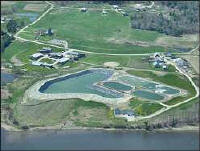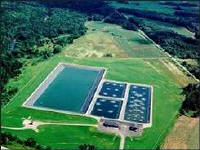The idea behind colorimetry is very simple. But first here
is a simplistic review of color: most substances absorb at least a
little bit of light. Black objects absorb all the colors of the
rainbow and reflect little light. White objects absorb almost no color
and reflect all the colors of the rainbow (called white light). In
between, most objects absorb some light and reflect the rest. That is
how we see different colors – a red object absorbs all the light
except the red wavelength, which reflects off the subject and appears
red to us. Similarly, a blue object absorbs all the light except the
blue wavelength. In reality, though, most colors we see are blends of
several wavelengths being reflected back to us.
We can use this principle of color reflection and
absorption to determine the concentration of a chemical in solution
(like residual chlorine in water). There are two ways this has
typically been done; one uses Nessler tubes (these look like test
tubes) or a color wheel and the other uses a spectrophotometer. In
both cases the substance you want to determine the concentration of
needs to be color-enhanced by reacting it with a specific chemical. In
the case of phosphorus analysis, the phosphorus is reacted with
ammonium molybdate, potassium antimonyl tartrate, and ascorbic acid to
form a blue color; residual chlorine is reacted with DPD to form a red
color; and ammonia-nitrogen is reacted with Nessler reagent for form a
yellow to brownish-yellow color.
While each procedure has its own specific limitations, the
intensity of the color for each parameter is proportional to its
concentration. Here’s a simplified example to make this point clear:
if a phosphorus sample has twice the blue color intensity as another
sample of phosphorus, the first sample has twice the concentration of
phosphorus as the second sample.
In using Nessler tubes, a series of standard solutions is
made and reacted with its specific color-enhancing chemical. Then the
sample in question is color-enhanced and compared to the standards.
From this the concentration of the sample is determined. Note that
the color wheels of years ago worked on this same idea. Rather than
making a series of standards to compare color intensity, these colors
were printed on a wheel or card to which the liquid sample would be
compared. Both of these were very subjective tests, although easy and
quick to use in the field. Today, neither the use of Nessler tubes nor
color wheels are approved for NPDES reporting purposes.
A spectrophotometer works by a similar principle. But
rather than measuring the intensity of the reflected light (the color
your see) as with Nessler tubes, it measures the amount of a
particular wavelength that is absorbed by the sample. Usually the best
wavelength to use is the visible color’s complement. For example, if a
color-enhanced sample is red, a wavelength in the green part of the
spectrum is used in a spectrophotometer. The amount of this wavelength
that is absorbed by the sample is proportional to its concentration.
There are, however, limitations to colorimetry. Samples
must be diluted or occasionally concentrated so that a valid
measurement can be made since the workable range often falls within
only a few milligrams per liter. Sometimes non-target substances react
with the color-enhancing chemicals to create a false positive reading,
although test procedures are generally good at listing these
interferences and describe ways to counteract or reduce their effects.
Other interferences include bubbles in the sample cells or tubes,
turbidity of the sample, and sample color (the wastewater from a
textile dying process, for example, is nearly impossible analyze using
colorimetric methods). Fingerprints on the sample cells and optically
mismatched sample cells will also give erroneous readings.
Despite the challenges of colorimetry, it remains an
easy-to-use and accurate test if care is taken to match the sample
with the method limitations, the equipment is clean and in proper
working order, and a good quality assurance plan is in place to
indicate that the results are accurate.
If you have any questions, suggestions, or comments,
contact NEWEA Lab Practices Committee Chair Tim Loftus at (508)
949-3865
timloftus@msn.com. For more information on the NEWEA Laboratory
Practices Committee, please contact Tim Loftus or Elizabeth Cutone,
NEWEA Executive Director, 100 Tower Office Park, Woburn, MA 01801,
(781) 939-0908,
ecutone@newea.org.

